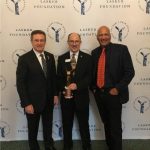September 19, 2017
 Michael N. Hall was awarded the 2017 Albert Lasker Basic Medical Research Award for discoveries in relation to Nutrient-activated TOR proteins that regulate cell growth.
Michael N. Hall was awarded the 2017 Albert Lasker Basic Medical Research Award for discoveries in relation to Nutrient-activated TOR proteins that regulate cell growth.
Michael N. Hall of the Biocenter at the University of Basel discovered the nutrient-activated TOR proteins and their central role in the metabolic control of cell growth. By showing that the TOR system adjusts cell size in response to the availability of raw materials, Michael N. Hall revealed an unanticipated linchpin of normal cell physiology.
The project that launched this route to discovery was a collaborative effort between Joseph Heitman, then an EMBO long term fellow working in Mike Hall’s lab at the Biocenter, together with Rao Movva a group leader and scientist at Sandoz Pharmaceuticals in Basel (now Novartis). Together the three demonstrated that FKBP12 is required for the action of rapamycin and discovered TOR as the target of the immunosuppressive drug rapamycin. This immunosuppressive and antifungal agent was discovered by Sehgal at Wyeth-Ayerst, but its targets and mechanism of action were unknown. Because rapamycin is a natural product of soil bacteria, Heitman, Movva, and Hall hypothesized that its natural activity might be to inhibit competing fungi in the soil, and that its target(s) might be conserved from fungi to humans. Their work in the model yeast Saccharomyces cerevisiae presaged discovery of the mammalian ortholog of yeast TOR (mTOR) by several years, and laid the groundwork for scientific and medical advances. Together the three took an unorthodox approach, employing yeast genetics to identify the targets of a potent immunosuppressive natural product, rapamycin. Via yeast genetic and molecular/biochemical approaches, the team identified the peptidyl-prolyl isomerase FKBP12 as the cellular receptor for rapamycin and discovered the yeast TOR1 and TOR2 proteins as the targets of the FKBP12-rapamycin complex. In so doing, they discovered an unknown protein complex and cascade that play central roles in nutrient sensing and cell growth control and are conserved from yeast to humans. Rapamycin and its analogs went on to receive clinical approval as immunosuppressive drugs for organ and tissue transplant recipients, and have also found broader indications in interventional cardiology and cancer chemotherapy. That rapamycin prolongs longevity by mimicking caloric restriction, enhances vaccination efficacy, and inhibits a target central to metabolism and responses to insulin and other growth factors, suggests additional possible clinical applications. Their fundamental discovery catalyzed extensive studies of this pathway, central to health and aging, and continues to foster novel therapeutic developments that broadly impact medicine and human health.
The Albert Lasker Award recognizes the contributions of researchers, clinician scientists, and public servants who have made major advances in the understanding, diagnosis, treatment, cure, or prevention of human disease. Lasker Awards program was created in 1945 by Albert and Mary Lasker to identify fundamental biological discoveries and clinical developments that improve human health, and to draw attention to the importance of public support of science. Awards are given in three categories:
Albert Lasker Basic Medical Research Award: for fundamental discovery that opens up a new area of biomedical science.
Lasker-DeBakey Clinical Medical Research Award: For major advance that improves the lives of many thousands of people.
Lasker-Koshland Special Achievement Award in Medical Science: For research accomplishments and scientific statesmanship that engender the deepest feelings of awe and respect.
Additional information and publications below:
Michael Hall (University of Basel): The Story or TOR (Target of Rapamycin)
Video: https://www.youtube.com/watch?v=VYVjE6HEgy0
http://www.nejm.org/doi/full/10.1056/NEJMcibr1709384#t=article
http://www.cell.com/cell/pdf/S0092-8674(17)30944-3.pdf